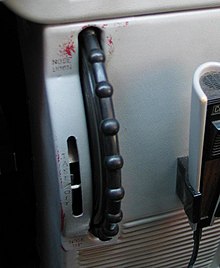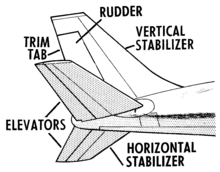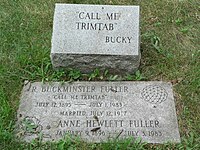Trim tab

This article needs additional citations for verification. (October 2008) |
Trim tabs are small surfaces connected to the trailing edge of a larger control surface on a boat or aircraft, used to control the trim of the controls, i.e. to counteract hydro- or aero-dynamic forces and stabilise the boat or aircraft in a particular desired attitude without the need for the operator to constantly apply a control force. This is done by adjusting the angle of the tab relative to the larger surface.
Changing the setting of a trim tab adjusts the neutral or resting position of a control surface (such as an elevator or rudder). As the desired position of a control surface changes (corresponding mainly to different speeds), an adjustable trim tab will allow the operator to reduce the manual force required to maintain that position—to zero, if used correctly. Thus the trim tab acts as a servo tab. Because the center of pressure of the trim tab is further away from the axis of rotation of the control surface than the center of pressure of the control surface, the moment generated by the tab can match the moment generated by the control surface. The position of the control surface on its axis will change until the movements from the control surface and the trim surface balance each other.
Uses in boats
Boats with outboard engines will often have trim tabs attached to the lower unit of the engine. These are used to adjust the pitch attitude of the boat while underway. Changes in boat speed or weight placement will usually require the trim tabs to be adjusted to keep the boat at a comfortable and efficient pitch attitude. This reduces the work of the helmsman by reducing the amount of manual control necessary, as well as providing for greater efficiency by keeping the ship in the ideal orientation for the conditions[citation needed].
Trim Tabs are most found on cruisers, sport fishing boats and center console boats ranging from 20 feet and up[citation needed].
In some sailboats, the trailing edge of the keel has a trim tab which is used to null out rudder forces (lee or weather helm)[citation needed].
Uses in aircraft

Many airplanes (including gliders) have trim tabs on their elevators, as a simple method of providing trim in the longitudinal axis.
All aircraft must have a system for ensuring trim in the longitudinal axis, though methods other than trim tabs may be used. Alternatives include:
- a spring attached to the control system that can be adjusted by the pilot
- in the case of the elevator, an all-moving horizontal stabilizer whose position can be adjusted in flight by the pilot.
Elevator trim frees the pilot from exerting constant pressure on the pitch controls. Instead, the pilot adjusts a longitudinal trim control (often in the form of a wheel) to cancel out control forces for a given airspeed / weight distribution. Typically, when this trim control is rotated forward, the nose is held down; conversely, if the trim wheel is moved back, the tail becomes "heavy". Many newer aircraft, especially jet aircraft have electric trim controls.
Many airplanes also have rudder and/or aileron trim systems. On some of these, the rudder trim tab is rigid but adjustable on the ground by bending: it is angled slightly to the left to lessen the need for the pilot to push the rudder pedal constantly to overcome the left-turning tendencies of some prop-driven aircraft. Other aircraft have hinged rudder trim tabs that the pilot can adjust in flight.
When a trim tab is employed, it is moved into the slipstream opposite to the control surface's desired deflection. For example, in order to trim an elevator to hold the nose down, the elevator's trim tab will actually rise up into the slipstream. The increased pressure on top of the trim tab surface caused by raising it will then deflect the entire elevator slab down slightly, causing the tail to rise and the aircraft's nose to move down.[1] In the case of an aircraft where deployment of high-lift devices (flaps) would significantly alter the longitudinal trim, a supplementary trim tab is arranged to simultaneously deploy with the flaps so that pitch attitude is not markedly changed.
The use of trim tabs significantly reduces pilots' workload during continuous maneuvers (eg: sustained climb to altitude after takeoff or descent prior to landing), allowing them to focus their attention on other tasks such as traffic avoidance or communication with air traffic control.
Both elevator trim and pitch trim affect the small trimming part of the elevator on jet airliners. The former is supposed to be set in a certain position for a longer time, while the pitch trim (controlled with the landing pilots thumb on the yoke or joystick, and is thereby easy to maneuver) is used all the time after the flying pilot has disabled the autopilot, especially after each time the flaps are lowered or at every change in the airspeed, at the descent, approach and final. Elevator trim is most used for controlling the attitude at cruising by the autopilot.
Beyond reducing pilot workload, proper trim also increases fuel efficiency by reducing drag. For example, propeller aircraft have a tendency to yaw when operating at high power, for instance when climbing: this increases parasite drag because the craft is not flying straight into the apparent wind. In such circumstances, the use of an adjustable rudder trim tab can reduce yaw.
Trim tab as a metaphor

The engineer Buckminster Fuller is often cited for his use of trim tabs as a metaphor for leadership and personal empowerment. In the February 1972 issue of Playboy, Fuller said:
Something hit me very hard once, thinking about what one little man could do. Think of the Queen Mary—the whole ship goes by and then comes the rudder. And there's a tiny thing at the edge of the rudder called a trim tab.
It's a miniature rudder. Just moving the little trim tab builds a low pressure that pulls the rudder around. Takes almost no effort at all. So I said that the little individual can be a trim tab. Society thinks it's going right by you, that it's left you altogether. But if you're doing dynamic things mentally, the fact is that you can just put your foot out like that and the whole big ship of state is going to go.
So I said, call me Trim Tab.
— Buckminster Fuller
The official newsletter of the Buckminster Fuller Institute is called "Trimtab".[2]
References
- ^ The Anatomy Of The Aeroplane Darrol Stinton, ISBN 0-632-01876-3
- ^ member newsletter
